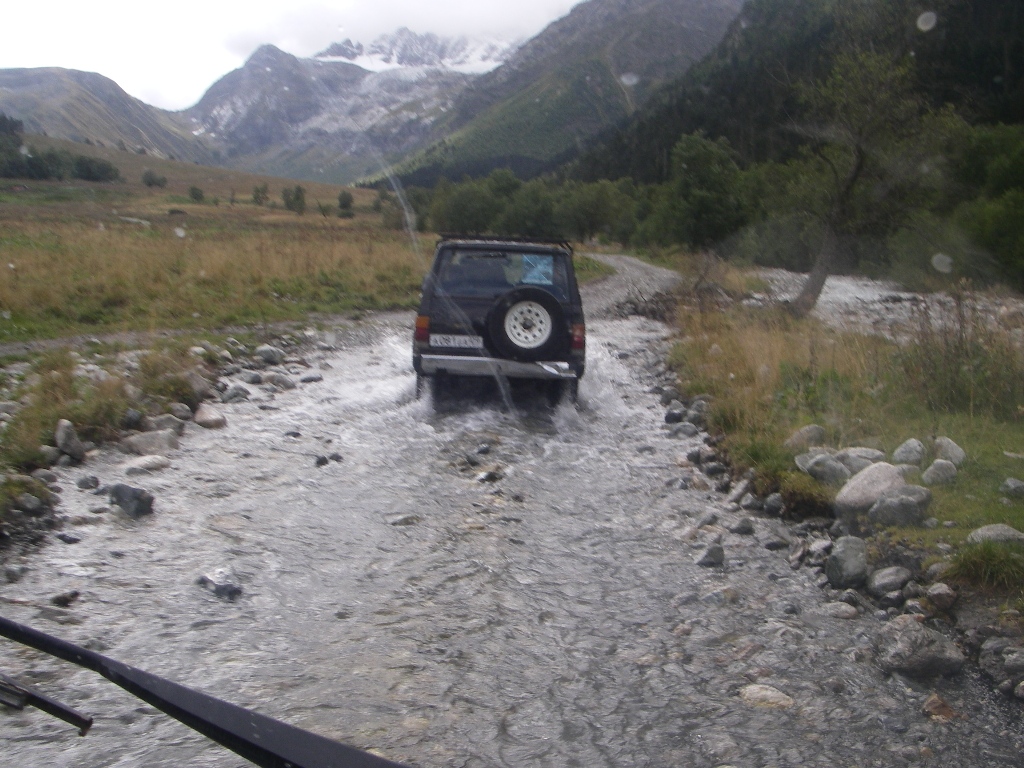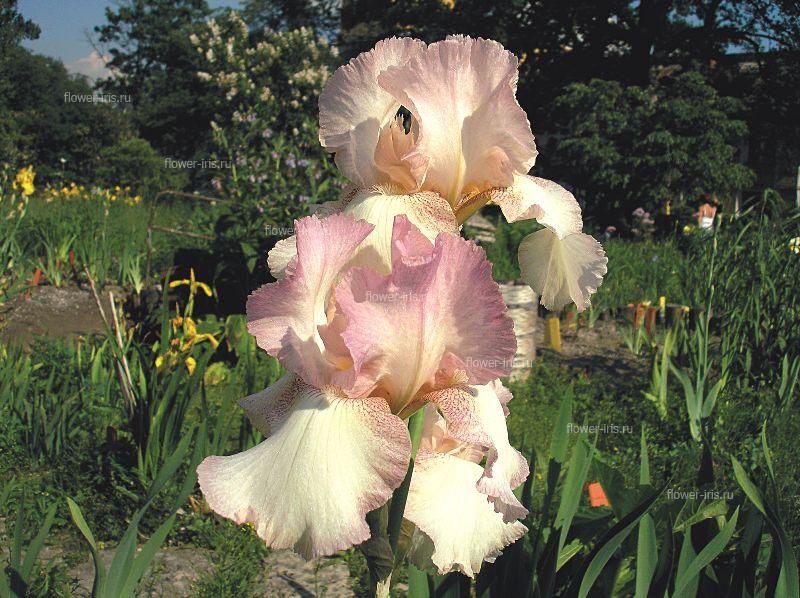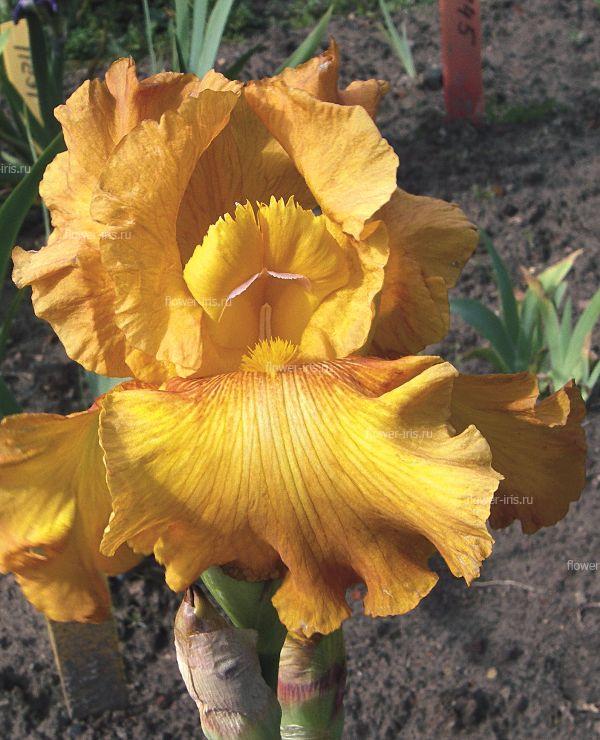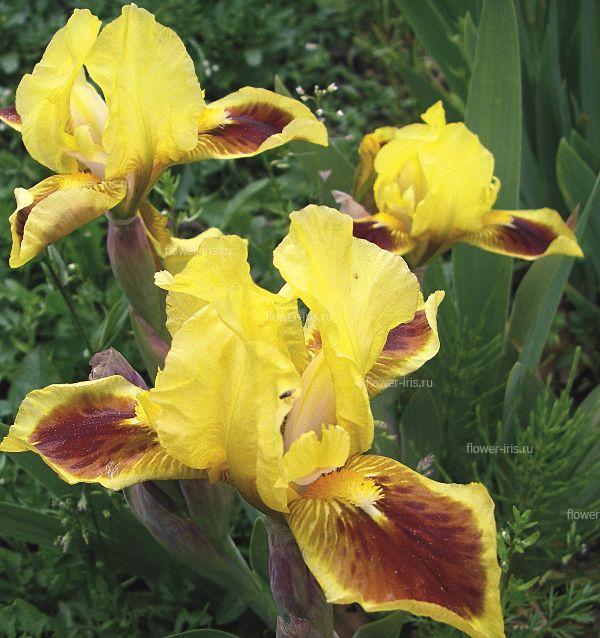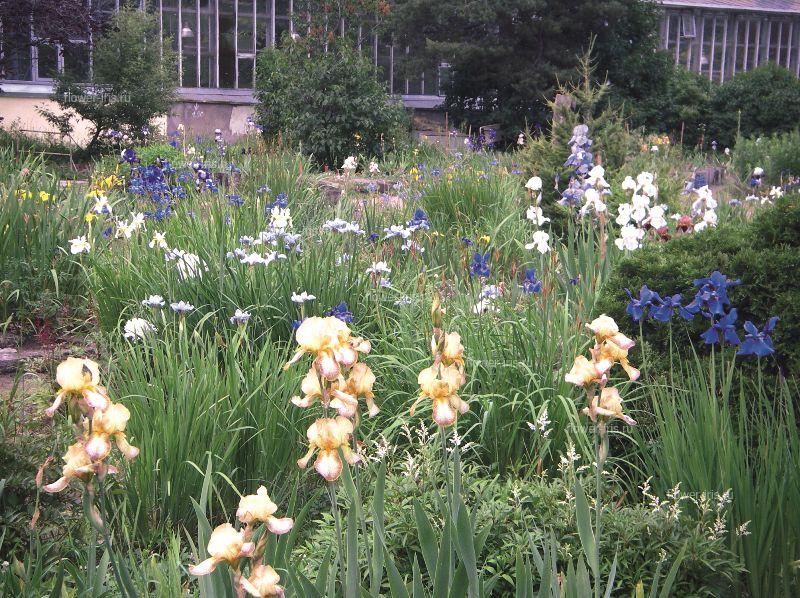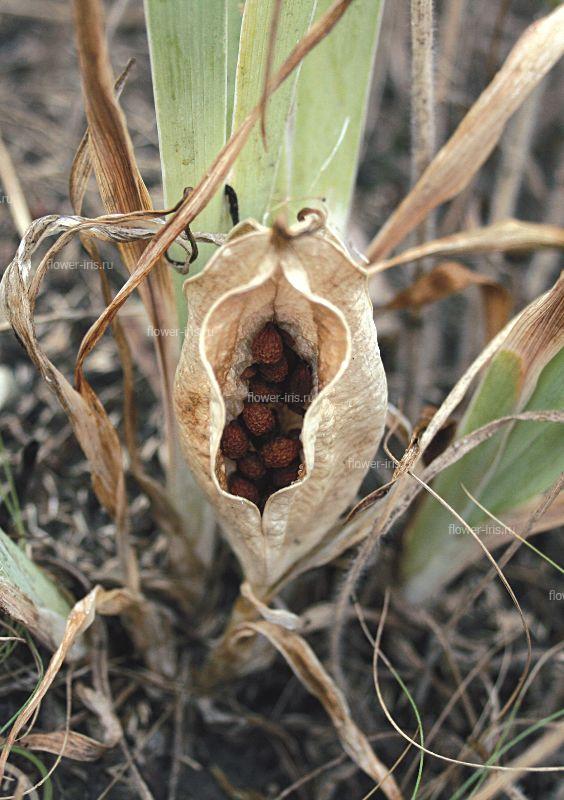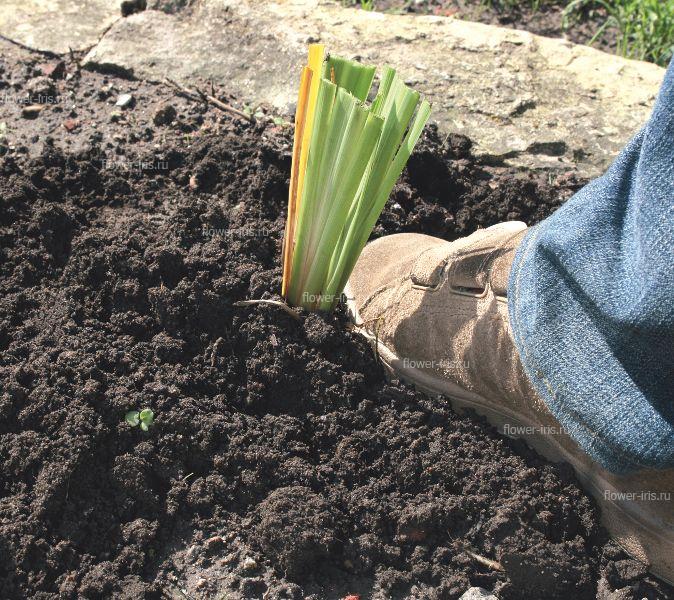|
News Photo Gallery |
The exhibition "Iris Russia"Homepage → Books on Iridarium (Iris Garden) → Look in the book → The exhibition "Iris Russia"
Introduction
Create iridariya Family Iridaceae Bulbotubers Bulbous Rhizomatous Genus Iris Subgenus Iris Subgenus Limniris Subgenus Eremiris Subgenus Xyridion Subgenus Tenuifolia Genus Pardanthopsis The exhibition "Iris Russia" Exposure Iris garden Cultivate Insect Pests and diseases of Irises Literature The translation is done through the service translate.google.com. Of great value is the collection of Iris Flora Russia. It is located on a geographical basis, and consists of three modules: Iris Siberian Iris Iris Primorye and the European part of Russia and the North Caucasus, with the addition of some plants, accompanying them in a natural habitat. Of the 40 species growing in the flora of Russia, the collection 30. Create a collection of the flora of Russia was mainly due to own forwarding collections and exchange with other botanical gardens. Cultivation and demonstration of rare species threatened by extinction, with one hand, to preserve and develop them in the culture, on the other - introduces fans of these unique plants and introduces visitors to the garden in mind the thought of having respect for the them in the wild. First to demonstrate the wide range of visitors to the exhibition Iridariya used 16 rare species, including three endemic species in the Red Data Book of the Russian Federation and other regional Red Books. Rare species and their protection in the wild.In order to understand how to organize the protection of plants, a list of rare and endangered plant species. Then identify such facilities in some parts of the country, that is, to draw up lists of species to be protected by region (Belousov, Denisova, 1979 Protected ... Saratov Region, 1979, Rare ... Siberia, 1980, Save the ... Don Basin, 1981, Rare ... USSR, 1981, 1983; Kharkevich, Kachura, 1981; Gorchakovskii, Shurova 1982, Save ..., 1984, Annunciation, and others, 1989; Shevchenko, 1990, Rare ... Vologda, 1991, Ivanov, 1995; Plaksina, 1998; Mironov Pavlova, 1999; Skvortsov, 2000, Semenov, 2003). One form of protection of rare and endangered species of living organisms - the creation of the Red Book. They provide information about the past and current distribution and abundance of species, brief information on their biological characteristics of the steps and the recommended protection measures (RSFSR, 1988, the Russian Federation, 2008), the republic (Yakutia, 1987, Komi, 1998; Buryatia, 2002 , Tuva, 2002), territorial and regional (Altai Territory, 1998; Arkhangelsk, 1995, Volgograd Region, 1992, Karelia, 1985, the Kurgan region, 2002, Lipetsk, 2005, Omsk Region, 2005, Rostov Region, 2004, Ryazan Province, 2002, Sochi 2002, the Central Urals, 1996, Stavropol Territory, 2002, Tver Region, 2002, Tyumen Region, 2004, Chita Region, 2002). According to the Red Book of the Russian Federation, republic, territory and province, 28 species of Iris have this or that category of qualitative evaluation of security objects, operating under the International Union for Conservation of Nature (IUCN) - The International Union of Conservation of the Nature. For Russia and its regions, to our knowledge, they are: 0 - Extinct (taxon extinct when there is no doubt that the last individual has died.) International symbol of this category - Ex (Extinct): I. glaucescens (Omsk region). 1 - Vanishing (including possibly extinct and exposed to danger of extinction). International symbol of this category - E (Endangered): I. acutiloba, I. notha, I. vorobievii. 2 - Vulnerable (reduced habitat and endangered species as a result of human activity). International symbol of this category - V (Vulnerable): I. aphylla, I. colchica, I. ivanovae, I. loczyi, I. ludwigii, I. notha, I. pallasii, I. pontica (= I. marshaliana), I. pseudonotha, I. pumila, I. sanguinea, I. scariosa, I. tigridia, I. timofejewii. 3 - Rare (occurring in a few places). International symbol - R (Rare): I. colhica, I. ensata, I. furcata, I. glaucescens, I. halophila, I. humilis, I. ivanovae, I. laevigata, I. potaninii, I. pseudacorus, I. sanguinea, I. sibirica, I. tenuifolia, I. tigridia, I. ventricosa. 4 - Uncertain. Their international symbol - In (Indeterminate): I. pallasii, I. ruthenica, I. sibirica. Some types of the object in the different regions have their own status. For example, the local endemic because fake (I. notha) in Stavropol - vulnerable, because its range is reduced and is in danger of extinction due to human activities - 2 (V), and in the Rostov region, he is in danger of extinction - 1 (E). Ivanov reduces its range and is in danger of extinction due to human activities in the Republic of Tuva - 2 (V), and in the Chita region is found only in a few places - 3 (R). As for the efficiency of the Siberian species, in the Stavropol region and the Ryazan region it is rare - 3 (R), and in the Altai region is the south-eastern boundary of its range, but while on the state of the population in the region is not sufficient, so there is this kind of with undefined status - 4 (In). In some cases, unfortunately, is not always possible to identify the occurrence of rare iris in the reserves. It is known that in the territories, only 31 of the 99 reserves in the Russian Federation, there are about 20 rare species (Reserves of the USSR, 1951; Zhudova, 1967 Reserves of the Soviet Union, 1969 Flora and ..., 1972, 2002; Minyaev, End, 1976; Vasilchenko 1987 Reserves European RSFSR, 1988, 1989, Marina, 1987; Golyakov, 1994, Mironov, Pavlov, 1999). Location of many rare species are often scattered and small in size, and as it was not conducted well protected in reserves, the problem of preservation of rare and endangered species, this can be solved. To save the species should also introduce them to the culture and comprehensive study. The details of the species grown in the geographical area of the exhibition modules Iridariya. Since the greatest number of species native to Siberia - 24, this module begins with a description of them, followed by the geographical unit of plants of European Russia and the North Caucasus, 16 species grow here, and finally - Primorye Territory, which grows 11 species. For each species provides information on geographical distribution (Doronkin, 1987 Galushko, 1978, 1983, Mikheev, 2004, 2006, Pavlov, 1987 Keys to 1979). The analysis of security, carried out in nature, and also present data on the introduction of iris - from the time of the garden P. Demidov, Earl A. Razumovsky in front room and up to the present day (Toy, 1977, Demidov, 1786; Doronkin, Lamanova, 1987, Zinoviev, 2000, 2003, Introduction ..., 1979, Catalogue, 1989 Catalogues ..., 1873, Kister, 1857; Kichunov, 1909 Lepekhin, 1771, Lopatin, 1995; Mironov, 1980a, 1980b, 1982, 1990, 1998, Pallas, 1776; plants ..., 1961 Rakhimov, 2000; Rodionenko, 1988, 2002, Semenov, 2001, 2007; Syuzev, 1910 Mabuza, 1909 Shevchenko, 1977, 1980, 1986; Delectus seminum, 1820; Fischer, 1812; Index octavus, 1835 ; Pallas, 1781). It is believed that the introduction was successful with normal fruiting. However, the introduction of a positive result is not always associated only with the seeds, if you have normal annual irises bloom and they are capable of vegetative reproduction, the introduction can also be considered a success. At the same time, the introduction of performance measurement can be enhanced if the preference seed material obtained from the edge areas, or reduced, if the source material was obtained from the plants that are already in the culture, and also due to intensive agricultural technologies, shelters, irrigation, etc. on Forms are grouped by their uniqueness and value. Iris collected in SiberiaIn Siberia grows 24 species, 20 of which - rare or endangered. The collection of 20 species of cultivated iris. Special value has 8 species iris due to their narrow distribution and low numbers of individuals - since swollen, because dvucheshuyny, Ivanov, K. Kamelina, K. Ludwig, since single-flowered, k and k Pallas bluish. B? Most of the iris from Siberia vulnerable in nature, mainly due to human activities, although they are common - k Bludova, because smooth, because the blood-red, yellow k, k xiphoid, because milk white, because low since Potanin since Russian, because Siberian, because solelyubivy, room bristle. Okay so in the culture studied species show consistent results and outside the area. Bludova iris (Iris bloudowii). Mentioned in the lists of protected plants. Two populations that are protected in nature reserves "Azas" and "Tigeretskogo." First mentioned in the catalogs of the Botanical Garden, the seeds of Dorpat in 1829 in St. Petersburg Imperial Botanical garden cultivated since 1857 successfully grown in the garden Pomologicheskom E. Regel and J. Kesselring in 1885 for the sale of live plants and seeds. In the culture showed good results in the botanical gardens, and other centers of introduction, namely Moscow, Saint-Petersburg (winters without shelter), Novosibirsk, Chita. In Barnaul, in areas sornichaet Botanical Garden. Effectively looks at the rocky hills in group plantings of other iris colors. There are varieties of foreign selection. Domestic breeders unused. It is of interest to create a cool-irises, as characterized by high winter hardiness. (R) swollen Iris (Iris ventricosa). Included in the Red Book of the Russian Federation and the Red Book of the Chita region as a rare, occurring in a few places. Kind of poorly understood outside the growing area. In 1786, grown in the Botanical Garden P. Demidov in Moscow. Introduced several times in the introduction in Moscow and Chita (transfer sods, roots, seeds), but proved difficult to cultivate. Currently, blossoms and bears fruit in Vladivostok, Moscow (MGU Botanic Garden) and the Botanical Garden of Chita. In most gardens missing. Requires a dry, well-drained and sunny areas. In the selection is not involved. (R) smooth Iris (Iris laevigata). Included in the Red Book of the USSR and the Chita region as a rare, occurring in a few places. 11 populations is protected conservation areas (Baikal, Barguzin, Bolshekhekhtsirsky, Vitim, Zeya, Cedar Pad, Lazo, Sokhondinsky, Sikhote-Alin, Khingansky, Olekminsky). In the St. Petersburg Imperial Botanical Garden cultivated until 1857 in the garden Pomologicheskom E. Regel and J. Kesselring - from 1877 to 1917., Offered for sale as live plants and seeds. Tested with positive results in the botanical gardens, and other centers of introduction of Russia and the former Soviet Union, namely: Barnaul, Vladivostok, Kaunas, Kiev, Kirovsk, Moscow, Novosibirsk, Riga, St. Petersburg, Stavropol, Tallinn, Tomsk, Chita, Yakutsk. Is the perfect decoration for any body of water, as in the nature of species common in the marshy lowlands, wet meadows with swampy reed polubolotistymi and clayey soils. Vysokodekorativen in group plantings. Outstanding facility for breeding in Russia, including the cross-species hybridization. There are varieties of domestic (Mironov, Vladivostok) and foreign selection. Dvucheshuyny iris (Iris biglumis). There is not in the Red Book, or in protected lists. None, reserve, or reserve, federal and republican status is not protected. Was introduced into the introduction in Moscow, St. Petersburg, Chita. Pokazyvet sustainability and outside the area. The culture is mentioned since 1838 in the catalog of living plants of the Imperial Botanical Garden is listed since 1857 are grown in the garden Pomologicheskom E. Regel and J. Kesselring. Offered for sale as rhizomes and seeds. Winters without shelter. In Chita, blossoms and bears fruit. Interest as dekorativnolistvenny perennial for landscapers working in the steppe, semi-desert and desert areas. Can be used to heavy phytomelioration saline soils. In the presence of moisture in the deeper layers of the soil leaves during the growing season are lush green. In respect of the breeding species of interest to obtain forms that are resistant to saline soils and soil overheating sun. Varieties of domestic and foreign breeding are absent. (R) Yellow Iris (Iris pseudacorus). Included in the Red Data Book of the Stavropol region as rare. Three populations are under the protection of the Central Forest State Reserve, and Nizhnesvirsky Rdeyskogo reserves. First mentioned in the culture since 1781 in the Botanical Garden P. Demidov in Moscow. There, in the front room, in A. Razumovsky - from 1812 Pomologicheskom garden E. Regel and J. Kesselring from 1876 to 1917. offered for sale as live plants and seeds. The culture is very hardy. Tested in addition to Moscow and St. Petersburg, Barnaul, Novosibirsk, Omsk, Chita, Ufa, Stavropol. In St. Petersburg, has been tested 43 populations from different parts of the range. Is the perfect decoration for any body of water, because the nature of the plant characteristic of swampy lowlands and river banks. There are varieties of domestic and foreign selection. (V, R) Ivanova Iris (Iris ivanovae). Included in the Red Data Book of Buryatia as vulnerable at risk species in the Red Book of the Russian Federation and the Chita region as rare. Protected in Dauria, Katun and Sokhondinsky reserves called because mackerel. Introduced in the introduction of several botanical gardens (Novosibirsk, Chita), which shows consistent results. Introduced several times in the introduction to St. Petersburg (transfer sods, roots, seeds), but proved difficult to cultivate. Landing site should be well-drained, open to the sun and protected from the elements. Kamelina iris (Iris kamelinii). Species is not understood, since the recently discovered and described in 2005. Only one known location in Russia: Altai Republic, Koshagachsky district Ridge Chihachova about. Boguty, the northern slopes of the gravelly, 2500 m above sea level. m is of particular value. Since close to Potanin (I. potaninii). (R) blood red Iris (Iris sanguinea). Included in the Red Data Book of the Chita region as a rare, occurring in a few places. One of the populations in the territory Sokhondinsky Reserve. The culture was first mentioned in the St. Petersburg Imperial Botanical Garden in 1857 near Moscow cultivated Ol'gino since 1911 Flowering and fruiting in the botanical gardens of Barnaul, Vladivostok, Novosibirsk, Pyatigorsk, Ufa, Yakutsk, Chita. In the introduction unpretentious. In St. Petersburg winters without shelter. Valuable to the selection when creating a winter-hardy forms. Very decorative red-violet color base bracts. Suitable for cut flowers, trees and bushes growing over groups for mixborders soliternyh and landings on the background lawn. There are varieties of foreign selection. Created numerous interspecific hybrids involving this species. (V) Iris Lochan (I. loczyi). Included in the Red Book of the Republic of Tuva as vulnerable at risk species. View protected in UBSUNUR reserve. View has not been studied is the growing area. Tested in Ashgabat and Tashkent, but proved difficult to cultivate. Imported only whole individuals. Can be used for breeding resistant varieties. In the selection is not involved. (V) Ludwig Iris (Iris ludvigii). Included in the Red Book of Russia as vulnerable at risk species. None of the reserves or reserves of federal and republican status is not protected. Introduced several times in the introduction of Barnaul, Novosibirsk, St. Petersburg (transfer sods, roots, seeds), but even in the growing area in the introduction shows erratic results - almost no fruit. The Botanical Garden of St. Petersburg in 1971, bloomed three times. Dies after flowering. Winters without shelter. The plants are cultivated in the botanical gardens of Barnaul, Novosibirsk, Chita. Imported only whole specimens and rhizomes. In nature and in culture seeds ties rarely, most flowers, sterile with underdeveloped stamens. Good for the rocky hills and curbs. In the selection is not involved. (R) xiphoid Iris (Iris ensata). Included in the Red Book of the Russian Federation as a rare, occurring in a few places. One population is under the protection of Lazo Reserve. In the culture first appeared in the Imperial Botanical Garden in 1880 this time was grown in the garden Pomologicheskom E. Regel and J. Kesselring, as well as Ol'gino, near Moscow. Flowering and fruiting in the botanical gardens of Barnaul, Vladivostok, Moscow, St. Petersburg (winters with shelter), Chita and other intensively studied in Vladivostok, where a collection of 8 districts of Primorye Territory. Should continue to explore the most northern and mountain forms with a targeted introduction to the botanical gardens of the Northwest. In nature, it grows in damp meadows with soils having a slightly alkaline, which is close to the weak reaction. Suitable for landscaping ponds. Favorite subject of Japanese and American selection. Know a great number of varieties, including domestic and breeding. In northern areas requires careful shelter. Can be recommended for potting plants at harvest in pots for the winter in the basement. Milky white iris (I. lactea). Found in the list of protected plants. One of the populations that are protected in Dauria reserve. Perhaps in the early stages of introduction was tested under different names. The first information about its introduction into the North-West of the European part of Russia are in the boarding log Botanical Garden Botanical Sciences in 1970 Transbaikal botanical garden cultivated since 1991, blossoms and bears fruit. High seed production in Ufa. Interesting as decorative deciduous perennial for landscapers working in the steppe, semi-desert and desert areas. Can be used to heavy phytomelioration saline soils. In the presence of moisture in the deeper layers of the soil leaves during the growing season are lush green. Attracts the attention of its long history of use in traditional medicine. Was introduced into the introduction of Stavropol, St. Petersburg, and Chita, all showing consistent results. Interest in breeding for for forms that are resistant to saline soils and soil overheating sun. Specific data on participation in the form of domestic breeding there. There are varieties of foreign selection. (R) low Iris (Iris humilis). Included in the regional Red Books of Omsk and Tyumen regions as a rare, occurring in a few places. Many populations are protected by six reserves (Azas, the Baikal-Lena, Baikal, Barguzin, Sokhondinsky, Ubsunur). Perhaps the name of I. flavissima (k yellow), this species was grown from 1812 in a garden in the front room Razumovsky, near Moscow. Tested in St. Petersburg, Barnaul, Novosibirsk, Chita. Information on domestic breeding was found. There are varieties of foreign selection. Effective on the rocky hills and curb plantings. It is of interest to create a cold-resistant forms of Iris subgenus Iris section Psammiris, among the species of this group goes furthest to the north of Siberia. Single-flowered iris (Iris uniflora). There is not in the Red Book of the Russian Federation or in the list of protected plants. One of the population is under the protection of Lazo Reserve. In culture pokazyvet sustainability and outside the area. Since 1951, cultivated in the Botanical Garden of Moscow. Tested in St. Petersburg (winters without shelter), Khabarovsk, Vladivostok, Chita. In the culture of hardy, flowering and fruiting. The Botanical Garden of Vladivostok collected the most interesting collection, on which the observations and experiments on seed and vegetative propagation. Can be used to rocky hills, curbs and group plantings in the southern forest-steppe and steppe regions of Russia. In nature, confined to the dry soils. In domestic breeding not involved. There are varieties of foreign selection. (In) Pallas Iris (Iris pallasii). Included in the Red Data Book of the Altai region as indefinite an endangered species. None of the reserves or reserves of federal and republican status is not protected. In culture pokazyvet sustainability and outside the area. First mentioned in the Catalogue of the Botanical Garden, the Dorpat in 1822 introduced several times in the introduction to St. Petersburg, Chita (transfer sods, roots, seeds). Winters without shelter. Seeds are tied. In the selection was not involved. (R) Potanin Iris (Iris potaninii). Included in the Red Data Book of the Altai region as rare. One of the population is under the protection Daursky Reserve. Tested in Barnaul, Chita from 1992 shows consistent results and outside the area. In St. Petersburg winters without shelter, flowers. There is one variety (cv. Ionantha) foreign selection. As in nature, is an inhabitant of rocky steppes, rocky and gravelly slopes, in the introduction to the sublime dry habitat. Suitable for the type of rocky hills, mixborders. (In) Russian Iris (Iris ruthenica). In 2004, included in the regional Red Data Book as endangered, the Tyumen region. Many populations are protected 10 reserves (Azas, the Baikal-Lena, Baikal, Barguzin, Katun, Sokhondinsky, Posts, Sayano-Shushenskaya, Tigeretsky, Tsentralnosibirsky). First introduced to the culture of C. Ledebour in 1831 (Dorpat). Grown in the garden Pomologicheskom E. Regel and J. Kesselring from 1873 for sale as rhizomes and seeds. Very hardy in culture. Showed good results in the botanical gardens, and other centers of introduction of Barnaul, Irkutsk, Moscow, St. Petersburg, Stavropol, Tomsk, Omsk, Novosibirsk, Chita, etc. The natural diversity of species in the culture is not covered. Is xeromesophyte. Valuable plant to the rocky hills and curbs landings, and early-flowering forms in proliferation dekorativnolistvennye turf. Durable. Hardy. There are varieties of foreign selection (cv. Dykesii, Gamlin Blue). In domestic breeding has not been used. (R, In) Siberian Iris (Iris sibirica). Included in the regional Red Books of Omsk, Tver and Tyumen regions and Stavropol - the edge of a rare, occurring in a few places, and in the Altai region - as a kind of vague. Two populations are protected and Visimsky Polistovsky reserves. First cultivated by Gregory Demidov in Solikamsk garden in 1780 in St. Petersburg Imperial Botanical Garden is mentioned in 1857, in Moscow, in the front room - until 1812 at Moscow, in Ol'gino - grown from 1909 to 1911. In the garden Pomologicheskom E. Regel and J. Kesselring from 1873 to 1917. offered for sale live plants and seeds. The culture is very hardy, including outside the natural range. Flowering and fruiting in the botanical gardens of Barnaul, Vladivostok, Moscow, Novosibirsk, St. Petersburg, Ufa, Chita. In St. Petersburg winters without shelter. Soil prefers rich, moist, slightly acidic. Valuable to the selection when creating a winter-hardy forms. Suitable for cut flowers, trees and bushes growing over groups for mixborders soliternyh and landings on the background lawn. There are varieties of domestic (Rodionenko, St. Petersburg; Dolganova, Barnaul, Mironov, Vladivostok) and varieties of foreign selection. Created numerous interspecific hybrids. (Ex, R) bluish Iris (Iris glaucescens). Included in the regional Red Books of the Omsk region as a species, apparently extinct, and the Altai Territory - as rare. None of the reserves or reserves of federal and republican status is not protected. Kind of poorly understood outside the growing area. Introduced several times in the introduction of Barnaul, Novosibirsk, St. Petersburg (winters without shelter), Ufa (transfer sods, roots, seeds), but proved difficult to cultivate. In a culture often vyprevayut suffers from waterlogged soil. Recommended growing on dry upland. The view is very valuable in the respect due to the decorative polychrome appearance and beautiful form falcate leaves. Can be used as early spring perennial for rocky hills. In selection was not involved. (R) solelyubivy Iris (Iris halophylla). Species is included in the Red Data Book of the Omsk region and the Red Book of the Stavropol Territory as rare. None of the reserves is not guarded. Widely introduced in the introduction, showing consistent results and outside the area. For the first time in Russia began to be cultivated in the garden in Moscow P. Demidov in 1781 were grown in front room of A. Razumovsky since 1812, in the St. Petersburg Imperial Botanical Garden - from 1840 to Pomologicheskom garden E. Regel and H. Kesselring - c 1874 to 1917. under the name of I. gueldenstaedtiana (k Guldenshtadta). Offered for sale as live plants and seeds 7 of its forms. Grown near Moscow, in Ol'gino, seeds offered for exchange. The culture is very hardy. Tested in Barnaul, Novosibirsk, Omsk, Rostov-on-Don, St. Petersburg (winters without shelter), Sverdlovsk, Stavropol, Chita, Ufa. A variety of forms of nature are not covered. Is of special interest to grow in the gardens, and for breeding. It prefers moist soil. Due to gravity, and even salt tolerance to saline habitats can be used to grow in areas with excess salinity. (V, R) Tiger Iris (Iris tigridia). Included in the Red Data Book of Tyva as vulnerable at risk species in the Red Data Book of the Altai Territory as rare. First mentioned in the Catalogue of living plants of the Imperial St. Petersburg Botanical Garden in 1857, was put into the introduction of a few botanical gardens (Barnaul, Novosibirsk, Chita), which shows consistent results, blossoms, fruits, but not enough. Kind of poorly understood outside the growing area. Introduced several times in the introduction to St. Petersburg (transfer sods, roots, seeds), but proved difficult to cultivate. Not flowered seeds are tied. Picky about drainage, lighting, does not tolerate waterlogging. Recommended only for rocky hills. In the selection was not involved. It is of interest for hybridization to create varieties of iris flower with spotted. (R) fine-leaved Iris (I. tenuifolia). Included in the Red Data Book of the Chita region as rare. Protected in Dauria and Khopyor reserves. First mentioned in the introduction to the 1812 in the garden in the front room A. Razumovsky near Moscow. In the garden Pomologicheskom E. Regel and J. Kesselring from 1875 to 1915. offered for sale as live plants and seeds. Since 1876 - in the Index seminum St. Petersburg. Tested in Chita. Interesting as a soil-cover plants in steppe areas, but malodekorativen. Can be used in selection works in deriving highly resistant to drought conditions forms. In the selection is not involved. Bristle iris (Iris setosa). There is not in the Red Book, or in the list of protected plants. Two populations are protected and Lazo Alekminskogo reserves. Grown in the St. Petersburg Imperial Botanical Garden since 1857 in the catalog Pomologicheskogo garden E. Regel and J. Kesselring offered for sale live plants and seeds from 1873 to 1917. Shows high stability and the prospects for growing Moscow, Stavropol, Ufa, Novosibirsk, Chita, Vladivostok, Yakutsk. In St. Petersburg winters without shelter. Has a high frost resistance, beyond all species of Iris comes to the north. Hygrophilous. Interest for the Far North. Set of intraspecific forms very rich, but still little is involved in domestic breeding. Created more than 50 varieties of foreign selection, for example, cv. Beautiful Stranger, Blota Hunka, Moorse, Tourist, etc. Iris collected in the European part of Russia and the North CaucasusOf the 16 species, distributed in the European part of Russia and the North Caucasus, 15 - rare or endangered, of which 4 species grows only in Russia - because fake, because lozhnonenastoyaschy, because skinny, because Timofeev. On Iridarii BIN RAS grown 11 species. Especially valuable are the two types of iris - k and k ostrodolny Klatt, as they are in immediate danger of extinction of the flora of Russia (or the world), and deserve priority protection. Represents the value of another 6 - k fork, because skinny, because Colchis, room lozhnonenastoyaschy, because fake, because Pontiac - due to their limited distribution within Russia and the low number of individuals. Five species - because leafless, because dwarf, because yellow, because the Siberian and because solelyubivy - widely distributed in the European part of Russia, but their number is reduced in the entire range due to human activities. (V) leafless Iris (Iris aphylla). Included in the Red Book of Russia as vulnerable at risk species. Protected in nature reserves, Moscow, Rostov and Saratov regions. Was introduced into the introduction in Moscow, Stavropol, St. Petersburg, Chita. Shows consistent results and outside the area. Known in culture for over 400 years (Poletika Mishenkova, 1967). Successfully grown in temperate zones to Kirovsk inclusive. There are in room culture. For the first time in Russia introduced the culture of Moscow, in A. Razumovsky in front room in 1812, is grown in the St. Petersburg Imperial Botanical Garden from 1857 to Pomologicheskom garden E. Regel and J. Kesselring grown live plants for sale from 1906 to 1917 years. In the culture of enduring. Hybridizes easily with other bearded irises. Widely used in breeding to create varieties of irises srednerosloe. In the feature selection should be used to finish on time because leafless vegetation. This species is of interest to create a frost forms srednerosloe irises. Particular forms of re-blooming characteristic (remontant). Participated in crosses to create more than 70 varieties of American selection. (R) fork Iris (Iris furcata). Included in the Red Data Book of the Stavropol region as rare. None of the reserves is not guarded. Was introduced into the introduction in Moscow, St. Petersburg, Stavropol. Shows consistent results and outside the area. The culture was first mentioned in Dorpat in 1820 in St. Petersburg at the Imperial Botanical Garden - since 1838 The Catalogue E. Regel and J. Kesselring - from 1885 for sale offered as rhizomes and seeds. The collection BIN RAS - since 1941 winters without shelter. From the Botanical Gardens (Moscow) - from 1948 Requires dry, lightly shade locations. In the foothills of the North Caucasus grows on the slopes of different exposures, light and soil moisture, often together with efficiencies dwarf (I. pumila), however, does not give the interspecific hybrids. It is of interest for breeding. Varieties of domestic and foreign breeding are absent. (R) Yellow Iris (Iris pseudacorus). Included in the Red Data Book of the Stavropol region as rare. Three populations is protected Central Forest State Reserve, and Nizhnesvirsky Rdeyskogo reserves (his introduction, see the "Siberian Iris"). (V) Dwarf Iris (Iris pumila). Included in the Red Book of the Russian Federation and the Rostov region as vulnerable at risk species. Four populations are on the reserve (Astrakhan, Galichya Gore Zhigulevsky, Hopersky). As is known from the introduction in 1780 in the garden Demidov Solikamsk. Grown in the garden in Moscow P. Demidov and Ol'gino. In the Imperial Botanical Garden - from 1857. From 1876 to 1917. for sale in the garden Pomologicheskom E. Regel and J. Kesselring grown 26 varieties. Promising, but needs shelter in snowless winters. Conditions were tested in Stavropol Ufa, Chita. The view is very polymorphic, has a rich range of shades. It is of interest to curb landings with good drainage. There are varieties of domestic breeding. G. Shevchenko (Stavropol) Maximum coverage diversity of our natural populations. There are varieties of foreign selection. Klatt iris (Iris klattii). Not included in the Red Book of the Russian Federation, and it is not in the protected list. Not protected in any of the reserves or reserves of federal and republican status. The first information with positive results - in the Main Botanical Garden (Moscow), where in 1954, was tested under the name since Violet (I. violacea). Grown in Stavropol, which is rated as a promising crop for planting. In the St. Petersburg flowers, fruits, winters without shelter. Successfully cultivated as a rather dry slopes, and wet zapadinkah, which becomes particularly large size. Interest to grow in culture and in crosses with other species of the section. There are varieties of domestic (Rodionenko, St. Petersburg) and foreign selection. Grown in several botanical gardens (Moscow, Stavropol, St. Petersburg), all showing consistent results. (V) leathery Iris (Iris scariosa). Included in the Red Book of the Russian Federation, Stavropol and Rostov region as vulnerable at risk species. One of the population is under the protection of the Astrakhan Nature Reserve. First introduced in the introduction of the Main Botanical Garden of Academy of Sciences of the USSR in 1946 on Iridarii BIN RAS first tested in 1962 shows unstable results; blooms than annually, or fruit, falls heavily over the winter. Successful experiments on growing species recorded in the Botanical Garden of Stavropol. Suitable for rocky hills and curbs. In domestic breeding did not participate. Foreign breeders mistakenly called because bluish (I. glaucescens). (R, V) Colchis Iris (Iris colchica). Included in the Red Book of Sochi as a rare and Stavropolkogo edge as vulnerable. Protected in the Caucasian Reserve. The successful delivery of the introduction in Stavropol, where blossoms and bears fruit. Outside of the range shows unstable results (St. Petersburg). Good for the rocky hills and curbs. In the selection is not involved. (V) lozhnonenastoyaschy Iris (Iris pseudonotha). Included in the Red Data Book of the Stavropol Territory as vulnerable, endangered species affected. None of the reserves or reserves of federal and republican status is not protected. The Botanical Garden of Stavropol grown from 1986 in the collection Iridariya - since 1995 in the culture hardy. Flowering and fruiting, winters without shelter. Prefers salty and damp places. Due to salt tolerance can be used to grow in areas with excess salinity. A variety of forms of nature are not covered. Specific data on participation in the selection of species not. Is of interest to grow in the gardens, and for breeding. (V, E) is not real Iris (I. notha). Included in the Red Book of the Russian Federation, Stavropol Territory as vulnerable at risk species, and the Rostov region - as endangered. One of the small populations under the protection of the Botanical Reserve on Mount Strizhament (near Stavropol). In the culture first appeared in the St. Petersburg Imperial Botanical Garden in 1841, offered for sale in the garden Pomologicheskom E. Regel and J. Kesselring since 1884 was tested in many botanical gardens and nurseries (Moscow, Syktyvkar, Michurinsk, Samara, Stavropol, Nalchik, Dnepropetrovsk, Uzhgorod, St. Petersburg). Winters without shelter. Suitable for park planting and cutting. In wet soils weakens and dies, but during flowering requires instantaneous hydration and irrigation. (E) ostrodolny Iris (Iris acutiloba). Included in the Red Book of the Russian Federation as endangered. Only population falls into the territory of the reserve created to protect the unique flora Sarykumskogo dune Buinaksk district in Dagestan. Introduced several times in the introduction (the transfer of sods or rhizomes), but proved difficult to culture in a number of botanical gardens - Tbilisi, Baku, Frunze. In Moscow and St. Petersburg in culture showed unstable results. (V) Pontiac Iris (Iris pontica). Included in the Red Data Book of the Stavropol Territory, called C. Marshall as vulnerable affected endangered species. None of the reserves or reserves of federal and republican status is not protected. Kind of poorly understood outside of a natural habitat. Introduced several times in the introduction in Moscow, St. Petersburg, Stavropol (transfer sods, roots, seeds), but proved difficult to cultivate. Unstable in culture in Moscow and St. Petersburg. In the selection is not involved. (R, In) Siberian Iris (Iris sibirica). Included in the regional Red Books of Tver Region and Stavropol Territory as a rare, occurring in a few places, and the Altai region - as an undefined form. Two populations are protected and Visimsky Polistovsky reserves (his introduction, see the "Siberian Iris"). (R) solelyubivy Iris (Iris halophylla). Species is included in the "Red Book of the Stavropol Territory" as rare. In no reserve is not guarded. Widely introduced in the introduction, showing consistent results and outside the area (see his introduction, section Iris Siberia). Iris collected in Primorye On the territory of Primorye grows 10 species, 8 species - rare or endangered. All species are grown on Iridarii. Especially valuable are the five types - k swollen, because Vorobyov, because Maak, because Manchurian ostrolepestny because - due to their limited distribution within Russia. Human activities have led to reduction in the number 5 more species within the entire (often quite large) range: k smooth (Iris laevigata), since the blood-red (Iris sanguinea), because xiphoid (I. ensata), because single-flowered (Iris uniflora), because bristle (I. setosa). (R) swollen Iris (Iris ventricosa). Included in the Red Book of the Russian Federation and the Chita region as a rare, occurring in a few places (its introduction, see the "Siberian Iris"). (En) Iris Vorobyov (Iris vorobievii). Included in the Red Book of the Russian Federation as endangered. None of the reserves or reserves of federal and republican status is not protected. Maloizuchen view. The first experiments in his study of the nature and introductions were made at the Botanical Garden of Vladivostok L. Mironova in 1974 (transfer of grass, roots, seeds), but even there, proved difficult to cultivate. The culture is very difficult, seed production is low. As a rule, all types of iris rhizome immersed in soil or crawling on the surface. K. Vorobyev is an exception. It exists on the vertical rhizome 2-3 buds resume, but after flowering, they do not develop, and the plant dies. In the selection is not involved. (R) smooth Iris (Iris laevigata). Included in the Red Book of the USSR and the Chita region as a rare, occurring in a few places. 12 populations are protected nature reserves (its introduction, see the "Siberian Iris"). (R) blood red Iris (Iris sanguinea). Included in the Red Data Book of the Chita region as a rare, occurring in a few places. One of the populations in the territory of the reserve Sokhondinsky (its introduction, see the "Siberian Iris"). Maak iris (Iris maackii). Found in the list of protected plants in the Far East. In any reserve or reserve federal and republican status is not protected. Sustainably cultivated beyond its range. First introduced to the culture at Iridarii BIN RAS in 1989 in the culture hardy. Winters without shelter, flowers and fruits. In the selection is not involved. Promising for hybridization with smooth efficiency (I. laevigata) and other members of the subgenus Limniris. Manchurian Iris (Iris mandshurica). There is not in the Red Book, or in protected lists. One of the population is under the protection of natural monument "Senkina hat." Kind of poorly understood taxonomically. Introduced several times in the introduction of Vladivostok, St. Petersburg, Moscow, but proved difficult to culture outside the growing area. The Botanical Garden of Vladivostok collected the most interesting collection, on which the observations and experiments on seed and vegetative propagation. Can be used to rocky hills. Information on domestic breeding was found. There are varieties of foreign selection. (R) xiphoid Iris (Iris ensata). Included in the Red Book of the Russian Federation as a rare, occurring in a few places. One population are protected Lazo Reserve (its introduction, see the "Siberian Iris"). Single-flowered iris (Iris uniflora): see "Iris Siberia." Ostrolepestny iris (Iris oxypetala). There is not in the Red Book, or in protected lists. None of the reserves or reserves of federal and republican status is not protected. First look, it seems, took over large areas. May disappear altogether from the flora of Russia during the development area. First mentioned in the culture in 1879 in St. Petersburg Imperial Botanical Garden. Grown in the garden Pomologicheskom E. Regel and K. Kesselring in 1880, offered for sale as live plants and seeds. Was introduced into the introduction of Vladivostok, Moscow, Stavropol, St. Petersburg. Shows consistent results and outside the area. In selection was not used. Bristle iris (I. setosa): see "Iris Siberia." |


 Eng
Eng

